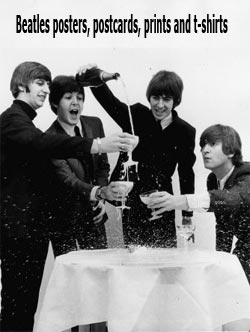In the December 1968 issue of
The Beatles Monthly Book (depicted below),
Mal Evans tells a story about a trip to Los Angeles with
George Harrison, where George discovered that their record company in USA, Capitol Records had "ruined" the Beatles new album. The album in question: "The Beatles", aka "the White album", which had yet to be released. Due out in mono and stereo in Europe, Capitol was to release the album in stereo only for the USA market. But they had messed with the album master tape which had been sent them from England. Mal Evans related how George was so upset by the cut he heard at Capitol that he took all day re-equalizing it so it sounded like it should.
George and Mal arrived in Los Angeles on October 16, 1968, primarily because Harrison was to produce songs for
Jackie Lomax' album "Is This What You Want?". While there, George also gave an
appearance on The Smothers Brothers Comedy Hour on 15 November, and returned to England later that month.
Bruce Spizer writes about this in his book "
The Beatles on Apple Records
": "George Harrison, along with Mal Evans, was in Los Angeles to produce Jackie Lomax's upcoming Apple album. He dropped by the Capitol Tower to hear the White Album. He had left London for LA prior to the banding session during which the order of the songs was selected for The White Album, and wanted to hear the finished product. He did not like what he heard and insisted that he be allowed to work with Capitol's engineers to remaster the album".
As detailed on page 270 of Bruce Spizer's book "
The Beatles Swan Song
" George Harrison did not approve of the original mastering job done by Capitol on the album. As was often the practice at the time, Capitol's engineers had run the sound signal through a limiter and compressed the volume range of the recording by cutting back the high volume peaks and bringing up the low passages. This would have been particularly noticeable on "Helter Skelter," with the fake fade-out ending, and Harrison's "Long, Long, Long," which has quiet passages throughout and loud distortion at the end.
According to
Eirik "The Norwegian" Wangberg, this work took place at Sound Recorders Studio on Yucca Street, which was located around the corner from the Capitol Tower. And it wasn't done by Capitol's engineers, but by Sound Recorders'
Armin Steiner, assisted by
Carl Frisk, while George was waiting in their lounge. George also produced sessions for the Jackie Lomax album at this studio at the time.
So, the album was saved and sounded like George Harrison wanted it to sound. It was released in the UK on 22 November 1968, and three days later in the United States. However, it seems a few of the U.S. albums had been pressed using Capitol's compressed master by mistake. In Perry Cox' 2007 book "
Price Guide For American Beatles Records
", one such copy of the album was described: "this variant has lacquer numbers in the trail off area ending in numbers LESS than 34. These records were pressed with metal parts generated from the initial 33 lacquers, which were supposed to be destroyed. George Harrison objected to the use of a limiter that had compressed the sound during the mastering process. He insisted that the initial lacquers be destroyed and that the album be remastered. Harrison's remastered version is found on standard copies of the album which have lacquer numbers 34 or higher. Only one copy, which is a VG- condition Scranton pressing with lacquer numbers A-28 and B-29, has been confirmed thought there are undoubtedly others out there."
And there was. A few more copies have surfaced since his book's publication, they pop up on ebay from time to time, and are very expensive. So if you're loaded with money and want to hear what The Beatles' white album should
not sound like, you have an opportunity. And for those with less money to spend, keep looking out for those lacquer numbers lower than 34 at garage sales!
 |
| From one of those elusive recalled pressings. |


































14 comments:
Surely this means both US mixes - pre and post George - sound different to the UK mix. I can believe George made the US mix sound more like what was in his head or even on a UK LP that perhaps was lying around, but surely it wouldn't be absolutely identical? Or is it?
I guess the mix is the same in the UK and US but the mastering is different.
I had no idea about this. First thing that popped into my head was what Nicki asked. Good thing George caught it though--imagine.
Thank you for this info! Great
Nice article. I'm assuming you thought to write this because of my Ebay sale of the copy you've pictured on Tuesday. As you used my photo of the front cover without credit, perhaps you'd like to provide a link to my website, Recordmecca.com, where I sell music collectibles and rare records like this. Best, Jeff Gold
Sure Jeff - no problem! Did it sell?
Yes, pretty quickly. First one I've ever found. Best, Jeff
It never rains, it pours...
On our Facebook page, David Heselden writes: You don't need to pay mega bucks here at all. Look for an early 70's USA Apple Winchester Pressing with Mastered By Capitol on the dead wax! It's exactly the same pressing with the compressed mix!
I've been lucky enough to find a few A-28 matrix White Albums over the past few years and even sent a needledrop of the best one (vg+) to Doug sulpy of the 910 who said it was the most "musical" pressing he'd ever heard (inagine that!) However, upon analysis (covered in an issue of the 910), he concluded that there really wasn't much (if any) difference between that pressung and a standard pressing, save perhaps a slight speed difference (although, no two pressings of the album are exactly the same speed, as Rutherford Chang's White Album x 100 has shown us).
I purchased a white album lp yesterday,and it is an apple release with the capitol logo on sides 2 and 4.
The number on the front cover is 1047279.
Would someone know if this would be a copy with the compressed stereo mix?
Harrison's reaction to over-compression is the same as mine. I don't like it. Except now, almost everything is way over compressed (so it will sound "louder" so it will sell better). I especially love the Blu-ray versions of Sgt. Pepper and the White Album partly because, unlike the CDs, no extra compression was added.
One thing few people seem to understand is how poorly sound transfers from one analog tape machine to another, even when the tape machines were state-of-the-art. By far the one main reason that the new mixes sound so much better is that the sound is derived from the first-generation multitrack tapes and mixed in the digital domain with no tape-to-tape transferring and therefore no generation loss in the mixing process.
Post a Comment